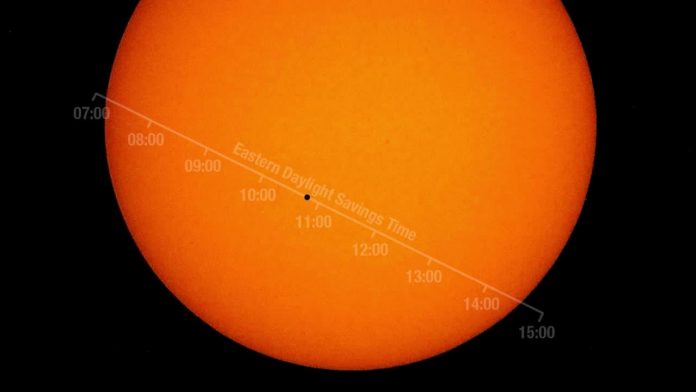The sky will put on a stellar show on Nov. 11, 2019, as Mercury crosses in front of the Sun. Transits of Mercury only happen about 13 times per century, so it’s a rare event you won’t want to miss!
With the *proper safety equipment, viewers nearly everywhere on Earth will be able to see a tiny dark spot moving slowly across the disk of the Sun. Because Mercury is so small from our perspective on Earth, you’ll need binoculars or a telescope with a certified Sun filter to see it.
Mercury’s orbit is inclined 7° to the ecliptic, the plane of Earth’s orbit, and intersects that plane at two points called nodes during each revolution around the Sun. The first intersection, called the descending node, occurs around May 8th when the planet crosses south of the ecliptic.
The second falls around November 10th, when Mercury intersects the plane moving north at the ascending node. Transits take place when the planet crosses a node at the same time it reaches inferior conjunction, passing directly between the Sun and the Earth. During November transits, Mercury is near perihelion and therefore farther from the Earth, the reason for its smaller apparent size of 10″ compared to 12″ for transits when it’s near aphelion in May.
The Sun spans 1.4 million kilometers across yet matches the Moon in apparent size. Positively puny. But compared to Mercury it’s a behemoth with the swagger of a true star. On the day of the transit Mercury will appear only 1⁄194 as large and will lie some 47 million kilometers from the Sun, or one-third of the Earth-Sun distance. It tiptoes onto the stage at 12:35 UT (7:35 EST), reaches the midpoint of its act at 15:30 UT (10:30 EST) and exits the solar disk at 18:04 UT (1:04 EST). Mercury remains visible for 5½ hours, providing lots of time for a break in the clouds in uncertain weather. And there will be clouds. For much of the U.S. November is the cloudiest month of the year.















